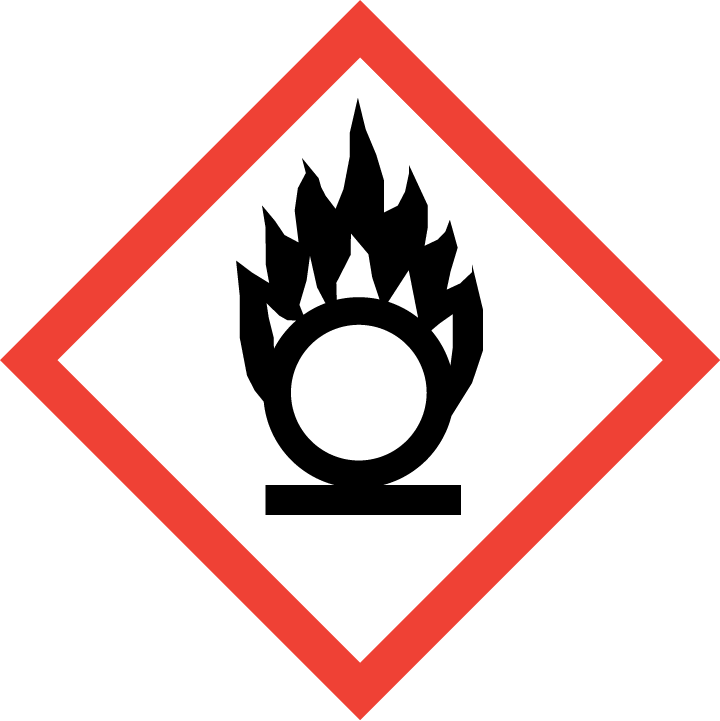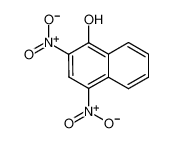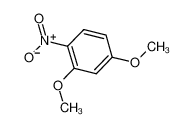1.Identification
1.1 GHS Product identifier
| Product name | dinitrogen tetraoxide |
|---|
1.2 Other means of identification
| Product number | - |
|---|---|
| Other names | nitrogen dioxide dimer |
1.3 Recommended use of the chemical and restrictions on use
| Identified uses | For industry use only. Fuels and fuel additives |
|---|---|
| Uses advised against | no data available |
1.4 Supplier's details
| Company | MOLBASE (Shanghai) Biotechnology Co., Ltd. |
|---|---|
| Address | Floor 4 & 5, Building 12, No. 1001 North Qinzhou Road, Xuhui District, Shanghai, China |
| Telephone | +86(21)64956998 |
| Fax | +86(21)54365166 |
1.5 Emergency phone number
| Emergency phone number | +86-400-6021-666 |
|---|---|
| Service hours | Monday to Friday, 9am-5pm (Standard time zone: UTC/GMT +8 hours). |
2.Hazard identification
2.1 Classification of the substance or mixture
Gases under pressure: Compressed gas
Oxidizing gases, Category 1
Skin corrosion, Category 1B
Acute toxicity - Inhalation, Category 2
2.2 GHS label elements, including precautionary statements
| Pictogram(s) |     |
|---|---|
| Signal word | Danger |
| Hazard statement(s) | H270 May cause or intensify fire; oxidizer H314 Causes severe skin burns and eye damage H330 Fatal if inhaled |
| Precautionary statement(s) | |
| Prevention | P220 Keep away from clothing and other combustible materials. P244 Keep valves and fittings free from oil and grease. P260 Do not breathe dust/fume/gas/mist/vapours/spray. P264 Wash ... thoroughly after handling. P280 Wear protective gloves/protective clothing/eye protection/face protection. P271 Use only outdoors or in a well-ventilated area. P284 [In case of inadequate ventilation] wear respiratory protection. |
| Response | P370+P376 In case of fire: Stop leak if safe to do so. P301+P330+P331 IF SWALLOWED: Rinse mouth. Do NOT induce vomiting. P303+P361+P353 IF ON SKIN (or hair): Take off immediately all contaminated clothing. Rinse skin with water [or shower]. P363 Wash contaminated clothing before reuse. P304+P340 IF INHALED: Remove person to fresh air and keep comfortable for breathing. P310 Immediately call a POISON CENTER/doctor/… P321 Specific treatment (see ... on this label). P305+P351+P338 IF IN EYES: Rinse cautiously with water for several minutes. Remove contact lenses, if present and easy to do. Continue rinsing. P320 Specific treatment is urgent (see ... on this label). |
| Storage | P410+P403 Protect from sunlight. Store in a well-ventilated place. P403 Store in a well-ventilated place. P405 Store locked up. P403+P233 Store in a well-ventilated place. Keep container tightly closed. |
| Disposal | P501 Dispose of contents/container to ... |
2.3 Other hazards which do not result in classification
none
3.Composition/information on ingredients
3.1 Substances
| Chemical name | Common names and synonyms | CAS number | EC number | Concentration |
|---|---|---|---|---|
| dinitrogen tetraoxide | dinitrogen tetraoxide | 10544-72-6 | none | 100% |
4.First-aid measures
4.1 Description of necessary first-aid measures
General advice
Consult a physician. Show this safety data sheet to the doctor in attendance.
If inhaled
Fresh air, rest. Half-upright position. Administration of oxygen may be needed. Refer immediately for medical attention.
In case of skin contact
First rinse with plenty of water for at least 15 minutes, then remove contaminated clothes and rinse again. Refer immediately for medical attention.
In case of eye contact
Rinse with plenty of water for several minutes (remove contact lenses if easily possible). Refer immediately for medical attention.
If swallowed
Rinse mouth. Do NOT induce vomiting. Refer immediately for medical attention.
4.2 Most important symptoms/effects, acute and delayed
Very concentrated fumes produce coughing, choking, headache, nausea, pain in chest and abdomen; otherwise, few symtoms appear at time of exposure. After symptom-free period of 5-72 hours, pulmonary edema gradually develops, causing fatigue, restlessness, coughing, difficulty in breathing, frothy expectoration, mental confusion, lethargy, bluish skin, and weak, rapid pulse. Since NOX interferes with gas exchange in lungs, unconscious- ness and death by asphyxiation can result, usually within a few hours after onset of pulmonary edema. (USCG, 1999)
4.3 Indication of immediate medical attention and special treatment needed, if necessary
Immediate first aid: Ensure that adequate decontamination has been carried out. If patient is not breathing, start artificial respiration, preferably with a demand-valve resuscitator, bag-valve-mask device, or pocket mask, as trained. Perform CPR as necessary. Immediately flush contaminated eyes with gently flowing water. Do not induce vomiting. If vomiting occurs, lean patient forward or place on left side (head-down position, if possible) to maintain an open airway and prevent aspiration. Keep patient quiet and maintain normal body temperature. Obtain medical attention. /Nitrogen Oxides (NOx) and Related Compounds/
5.Fire-fighting measures
5.1 Extinguishing media
Suitable extinguishing media
Extinguish surrounding fire using suitable agent. Use water spray to keep fire-exposed containers cool. Approach fire from upwind to avoid hazardous vapors. /Nitrogen oxides/
5.2 Specific hazards arising from the chemical
Special Hazards of Combustion Products: Produces toxic gas when heated. Behavior in Fire: Does not burn, but supports combustion of combustible materials such as wood. May cause fire or explode on contact with other materials. (USCG, 1999)
5.3 Special protective actions for fire-fighters
Wear self-contained breathing apparatus for firefighting if necessary.
6.Accidental release measures
6.1 Personal precautions, protective equipment and emergency procedures
Use personal protective equipment. Avoid dust formation. Avoid breathing vapours, mist or gas. Ensure adequate ventilation. Evacuate personnel to safe areas. Avoid breathing dust. For personal protection see section 8.
6.2 Environmental precautions
Evacuate danger area! Consult an expert! Personal protection: gas-tight chemical protection suit including self-contained breathing apparatus. Ventilation. Do NOT absorb in saw-dust or other combustible absorbents. Remove vapour with fine water spray. Neutralize used water with chalk or soda.
6.3 Methods and materials for containment and cleaning up
Releases may require isolation or evacuation. Stop or control the leak if this can be done without undue risk. Use water spray to disperse vapors and protect personnel. Approach release from upwind. Runoff of less volatile nitrogen oxides may contain highly corrosive nitric acid. /Nitrogen oxides/
7.Handling and storage
7.1 Precautions for safe handling
Avoid contact with skin and eyes. Avoid formation of dust and aerosols. Avoid exposure - obtain special instructions before use.Provide appropriate exhaust ventilation at places where dust is formed. For precautions see section 2.2.
7.2 Conditions for safe storage, including any incompatibilities
Ventilation along the floor. Separated from combustible substances and reducing agents.Store in tightly closed containers in a cool, well ventilated area away from oxidizable materials. Outside or detached storage is preferred. Do not put on wooden floors. /Nitrogen oxides/
8.Exposure controls/personal protection
8.1 Control parameters
Occupational Exposure limit values
no data available
Biological limit values
no data available
8.2 Appropriate engineering controls
Handle in accordance with good industrial hygiene and safety practice. Wash hands before breaks and at the end of workday.
8.3 Individual protection measures, such as personal protective equipment (PPE)
Eye/face protection
Safety glasses with side-shields conforming to EN166. Use equipment for eye protection tested and approved under appropriate government standards such as NIOSH (US) or EN 166(EU).
Skin protection
Wear impervious clothing. The type of protective equipment must be selected according to the concentration and amount of the dangerous substance at the specific workplace. Handle with gloves. Gloves must be inspected prior to use. Use proper glove removal technique(without touching glove's outer surface) to avoid skin contact with this product. Dispose of contaminated gloves after use in accordance with applicable laws and good laboratory practices. Wash and dry hands. The selected protective gloves have to satisfy the specifications of EU Directive 89/686/EEC and the standard EN 374 derived from it.
Respiratory protection
Wear dust mask when handling large quantities.
Thermal hazards
no data available
9.Physical and chemical properties
| Physical state | Transparent gas |
|---|---|
| Colour | Colorless gas |
| Odour | no data available |
| Melting point/ freezing point | -11ºC(lit.) |
| Boiling point or initial boiling point and boiling range | 21ºC(lit.) |
| Flammability | Not combustible but enhances combustion of other substances. |
| Lower and upper explosion limit / flammability limit | no data available |
| Flash point | no data available |
| Auto-ignition temperature | Not flammable (USCG, 1999) |
| Decomposition temperature | no data available |
| pH | no data available |
| Kinematic viscosity | no data available |
| Solubility | Reacts with water |
| Partition coefficient n-octanol/water (log value) | no data available |
| Vapour pressure | 1551 mm Hg (USCG, 1999) |
| Density and/or relative density | 2.62 g/mL at 25ºC(lit.) |
| Relative vapour density | (air = 1): 1.58 |
| Particle characteristics | no data available |
10.Stability and reactivity
10.1 Reactivity
no data available
10.2 Chemical stability
Stable under recommended storage conditions.
10.3 Possibility of hazardous reactions
Non-flammable. Nitrogen tetroxide does not burn but supports the combustion of carbon, phosphorus, and sulfur.The gas is heavier than air.Liquid NITROGEN TETROXIDE is an oxidizing agent consisting of an equilibrium mixture of colorless dinitrogen tetraoxide (N2O4) and red-brown nitrogen dioxide (NO2). The exact composition of the mixture depends on the temperature with higher temperature favoring conversion to NO2. Vaporizes readily to give NO2, also an oxidizing agent. Noncombustible but can accelerate the burning of combustible materials. Reacts with reducing agents to generate heat and products that may be gaseous (causing pressurization of closed containers). The products may themselves be capable of further reactions (such as combustion in the air). Reacts with alkalis to form nitrates and nitrites [Merck 11th ed. 1989]. Corrodes steel if wet, but can be stored in steel cylinders if dry [Merck]. Reacts explosively with liquid ammonia even at very low temperatures (below its freezing point) [Mellor, 1940, Vol. 8, 54]. Reacts energetically with boron trichloride [Mellor, 1946, Vol. 5, 132]. Mixtures with metal carbonyls are hypergolic (enflame immediately). Mixtures with halocarbons, hydrazine derivatives, heterocyclic bases (pyridine), isopropyl nitrite/propyl nitrite, active metals (magnesium, calcium, etc.), nitroaromatics, nitrogen trichloride, phosphorus, triethylamine, unsaturated hydrocarbons may react explosively. Accidental mixing with hot cyclohexane caused an explosion [MCA Case History 128. 1962]. A mixture with acetonitrile and indium showed no evidence of change for a time and then detonated when shaken (ascribed to the catalyzed oxidation of acetonitrile) [Chem. & Ind., 1958, 1004]. Mixture with alcohols produced a violent explosion [Chem. Eng. News, 1955, 33, 2372]. Vapor reacts with barium oxide incandescently [Mellor, 1940, Vol. 8, 545]. A slow reaction between the vapor and formaldehyde became explosive near 180°C [Trans. Faraday Soc. 45:767-770. 1949]. Manganese and potassium both ignite in the vapor [Ann. Chem. et Phys.(2) 2:317]. The vapor and ozone react with the evolution of light and often explode when mixed [J. Chem. Phys. 18:366. 1920].
10.4 Conditions to avoid
no data available
10.5 Incompatible materials
Stong oxidizers that enhance the combustion of easily oxidized materials, reducing agents, combustibles, organics. /Nitrogen oxides/
10.6 Hazardous decomposition products
When heated to decomposition it emits toxic fumes of /nitroxides/.
11.Toxicological information
Acute toxicity
- Oral: no data available
- Inhalation: LC50 Rabbit inhalation 315 ppm/15 min Note: this study refers to the mixture of nitrogen dioxide and nitrogen tetroxide. The exposure measurements are related to ppm nitrogen dioxide and does not set the LC50 for nitrogen tetroxide as such.
- Dermal: no data available
Skin corrosion/irritation
no data available
Serious eye damage/irritation
no data available
Respiratory or skin sensitization
no data available
Germ cell mutagenicity
no data available
Carcinogenicity
no data available
Reproductive toxicity
no data available
STOT-single exposure
no data available
STOT-repeated exposure
no data available
Aspiration hazard
no data available
12.Ecological information
12.1 Toxicity
- Toxicity to fish: no data available
- Toxicity to daphnia and other aquatic invertebrates: no data available
- Toxicity to algae: no data available
- Toxicity to microorganisms: no data available
12.2 Persistence and degradability
no data available
12.3 Bioaccumulative potential
no data available
12.4 Mobility in soil
no data available
12.5 Other adverse effects
no data available
13.Disposal considerations
13.1 Disposal methods
Product
The material can be disposed of by removal to a licensed chemical destruction plant or by controlled incineration with flue gas scrubbing. Do not contaminate water, foodstuffs, feed or seed by storage or disposal. Do not discharge to sewer systems.
Contaminated packaging
Containers can be triply rinsed (or equivalent) and offered for recycling or reconditioning. Alternatively, the packaging can be punctured to make it unusable for other purposes and then be disposed of in a sanitary landfill. Controlled incineration with flue gas scrubbing is possible for combustible packaging materials.
14.Transport information
14.1 UN Number
| ADR/RID: UN1067 | IMDG: UN1067 | IATA: UN1067 |
14.2 UN Proper Shipping Name
| ADR/RID: DINITROGEN TETROXIDE (NITROGEN DIOXIDE) |
| IMDG: DINITROGEN TETROXIDE (NITROGEN DIOXIDE) |
| IATA: DINITROGEN TETROXIDE (NITROGEN DIOXIDE) |
14.3 Transport hazard class(es)
| ADR/RID: 2 | IMDG: 2 | IATA: 2 |
14.4 Packing group, if applicable
| ADR/RID: unknown | IMDG: unknown | IATA: unknown |
14.5 Environmental hazards
| ADR/RID: no | IMDG: no | IATA: no |
14.6 Special precautions for user
no data available
14.7 Transport in bulk according to Annex II of MARPOL 73/78 and the IBC Code
no data available
15.Regulatory information
15.1 Safety, health and environmental regulations specific for the product in question
| Chemical name | Common names and synonyms | CAS number | EC number |
|---|---|---|---|
| dinitrogen tetraoxide | dinitrogen tetraoxide | 10544-72-6 | none |
| European Inventory of Existing Commercial Chemical Substances (EINECS) | Listed. | ||
| EC Inventory | Listed. | ||
| United States Toxic Substances Control Act (TSCA) Inventory | Listed. | ||
| China Catalog of Hazardous chemicals 2015 | Listed. | ||
| New Zealand Inventory of Chemicals (NZIoC) | Listed. | ||
| Philippines Inventory of Chemicals and Chemical Substances (PICCS) | Listed. | ||
| Vietnam National Chemical Inventory | Not Listed. | ||
| Chinese Chemical Inventory of Existing Chemical Substances (China IECSC) | Not Listed. | ||
16.Other information
Information on revision
| Creation Date | Aug 19, 2017 |
|---|---|
| Revision Date | Aug 19, 2017 |
Abbreviations and acronyms
- CAS: Chemical Abstracts Service
- ADR: European Agreement concerning the International Carriage of Dangerous Goods by Road
- RID: Regulation concerning the International Carriage of Dangerous Goods by Rail
- IMDG: International Maritime Dangerous Goods
- IATA: International Air Transportation Association
- TWA: Time Weighted Average
- STEL: Short term exposure limit
- LC50: Lethal Concentration 50%
- LD50: Lethal Dose 50%
- EC50: Effective Concentration 50%
References
- IPCS - The International Chemical Safety Cards (ICSC), website: http://www.ilo.org/dyn/icsc/showcard.home
- HSDB - Hazardous Substances Data Bank, website: https://toxnet.nlm.nih.gov/newtoxnet/hsdb.htm
- IARC - International Agency for Research on Cancer, website: http://www.iarc.fr/
- eChemPortal - The Global Portal to Information on Chemical Substances by OECD, website: http://www.echemportal.org/echemportal/index?pageID=0&request_locale=en
- CAMEO Chemicals, website: http://cameochemicals.noaa.gov/search/simple
- ChemIDplus, website: http://chem.sis.nlm.nih.gov/chemidplus/chemidlite.jsp
- ERG - Emergency Response Guidebook by U.S. Department of Transportation, website: http://www.phmsa.dot.gov/hazmat/library/erg
- Germany GESTIS-database on hazard substance, website: http://www.dguv.de/ifa/gestis/gestis-stoffdatenbank/index-2.jsp
- ECHA - European Chemicals Agency, website: https://echa.europa.eu/















